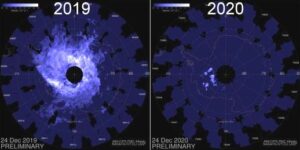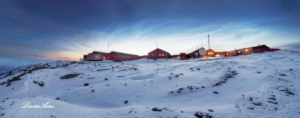Forwarded by our friend Dr. Volket Stracke DL8JDX, this new issue guides us through a very interesting world.
Something strange is happening 50 miles above Antarctica. Or rather, not happening. Noctilucent clouds (NLCs), which normally blanket the Frozen Continent in December, are almost completely missing. These images from NASA’s AIM spacecraft compare Christmas Eve 2019 with Christmas Eve 2020.
“The comparison really is astounding,” says Cora Randall of the University of Colorado’s Laboratory for Atmospheric and Space Physics. “Noctilucent cloud frequencies are close to zero this year.”
NLCs are Earth’s highest clouds. They form when summertime wisps of water vapor rise up from the poles to the edge of space. Water crystallizing around specks of meteor dust 83 km (~50 miles) above Earth’s surface creates beautiful electric-blue structures, typically visible from November to February in the South, and May to August in the North.
“The southern hemisphere stratosphere is very unusual this year” says Randall. “The ozone hole is exceptionally large, until recently zonal winds have been blowing in the wrong direction, and overall the stratosphere is much more ‘winter-like’ than it should be in December”
Hours after publication of this news item, NASA’s AIM satellite reported an uptick of NLC activity over Antarctica. “It’s still nowhere as many clouds as last year, but it makes sense given the recent steep drop in zonal wind speed and ozone hole area” notes Randall. “The atmosphere definitely has a mind of its own this season!“
Thanks and credit to: http://www.spaceweather.com and to Volker DL8JDX
Pic aside (Photographer: Jorgelina Alvarez) shows a noctilucent cloud s as viewed from Base Marambio (WAP ARG-21) in Antarctica.
Raltime Noctilucent Cloud Photo Gallery can be seen at: https://spaceweathergallery.com/nlc_gallery.html
